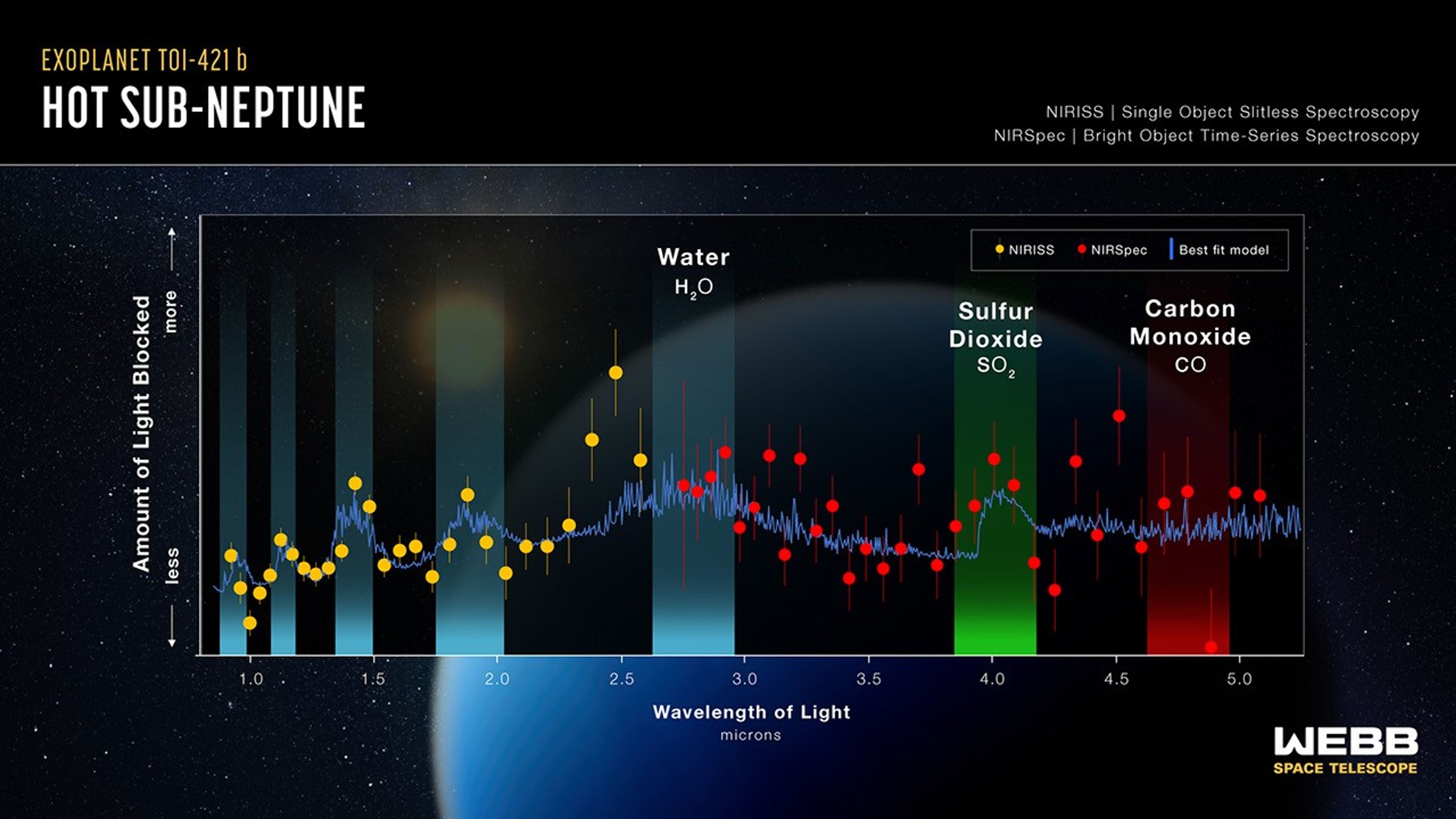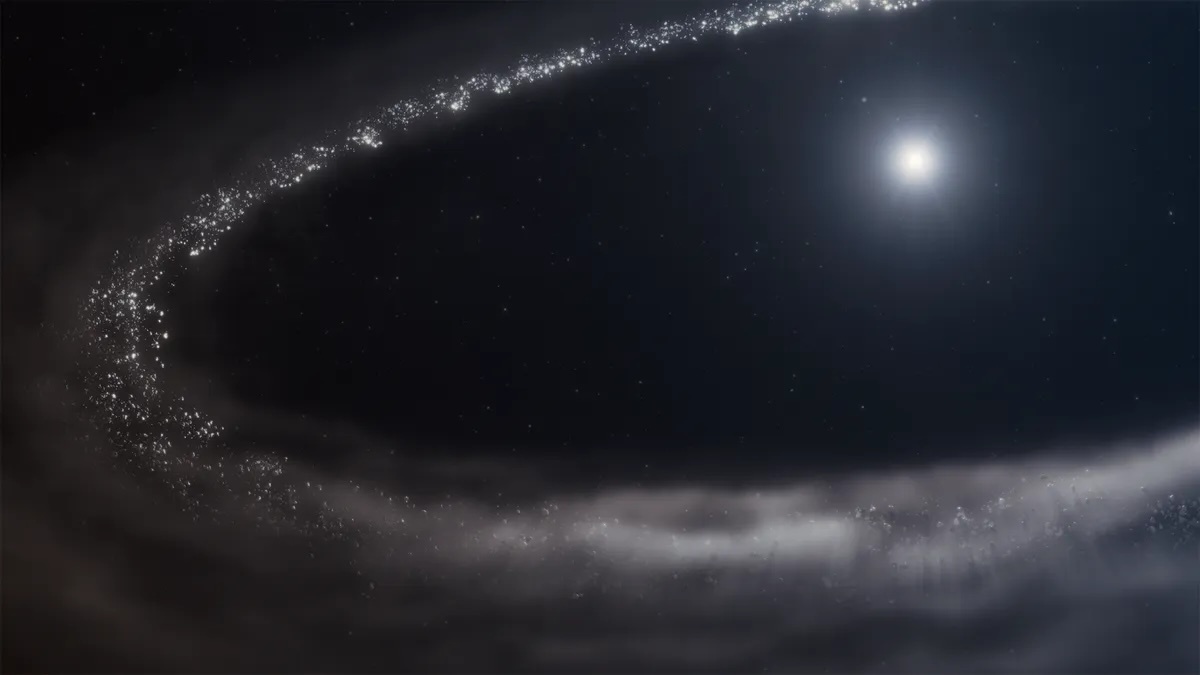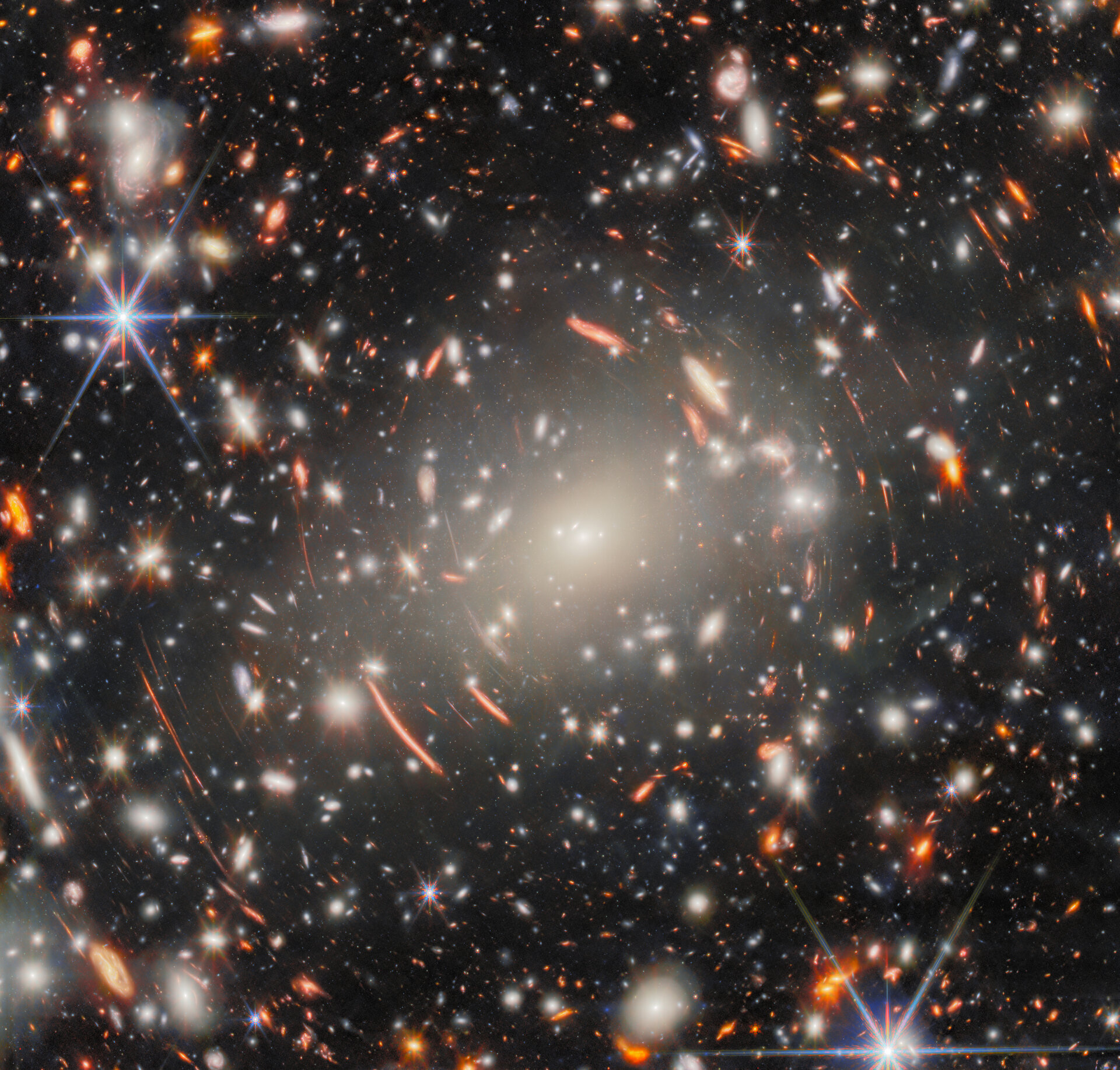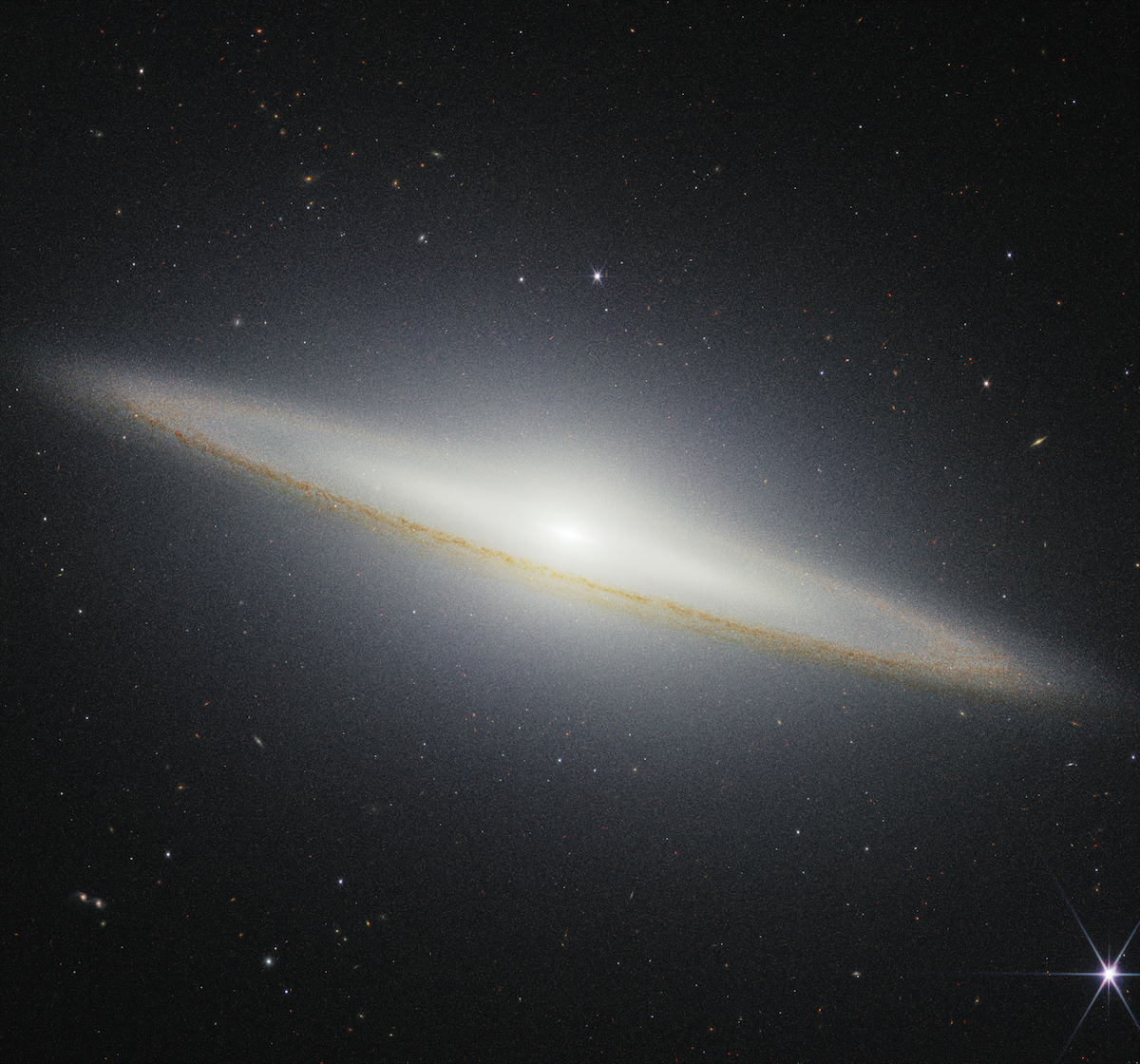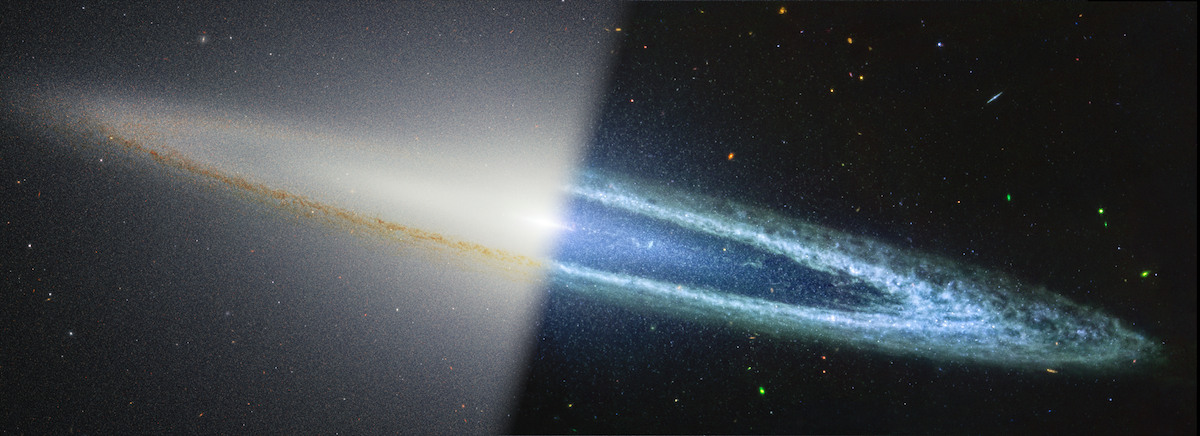7.05.2025
NASA’s Webb Lifts Veil on Common but Mysterious Type of Exoplanet
Though they don’t orbit around our Sun, sub-Neptunes are the most common type of exoplanet, or planet outside our solar system, that have been observed in our galaxy. These small, gassy planets are shrouded in mystery…and often, a lot of haze. Now, by observing exoplanet TOI-421 b, NASA’s James Webb Space Telescope is helping scientists understand sub-Neptunes in a way that was not possible prior to the telescope’s launch.
“I had been waiting my entire career for Webb so that we could meaningfully characterize the atmospheres of these smaller planets,” said principal investigator Eliza Kempton of the University of Maryland, College Park. “By studying their atmospheres, we’re getting a better understanding of how sub-Neptunes formed and evolved, and part of that is understanding why they don't exist in our solar system.”
Image A: Artist’s Concept of TOI-421 b
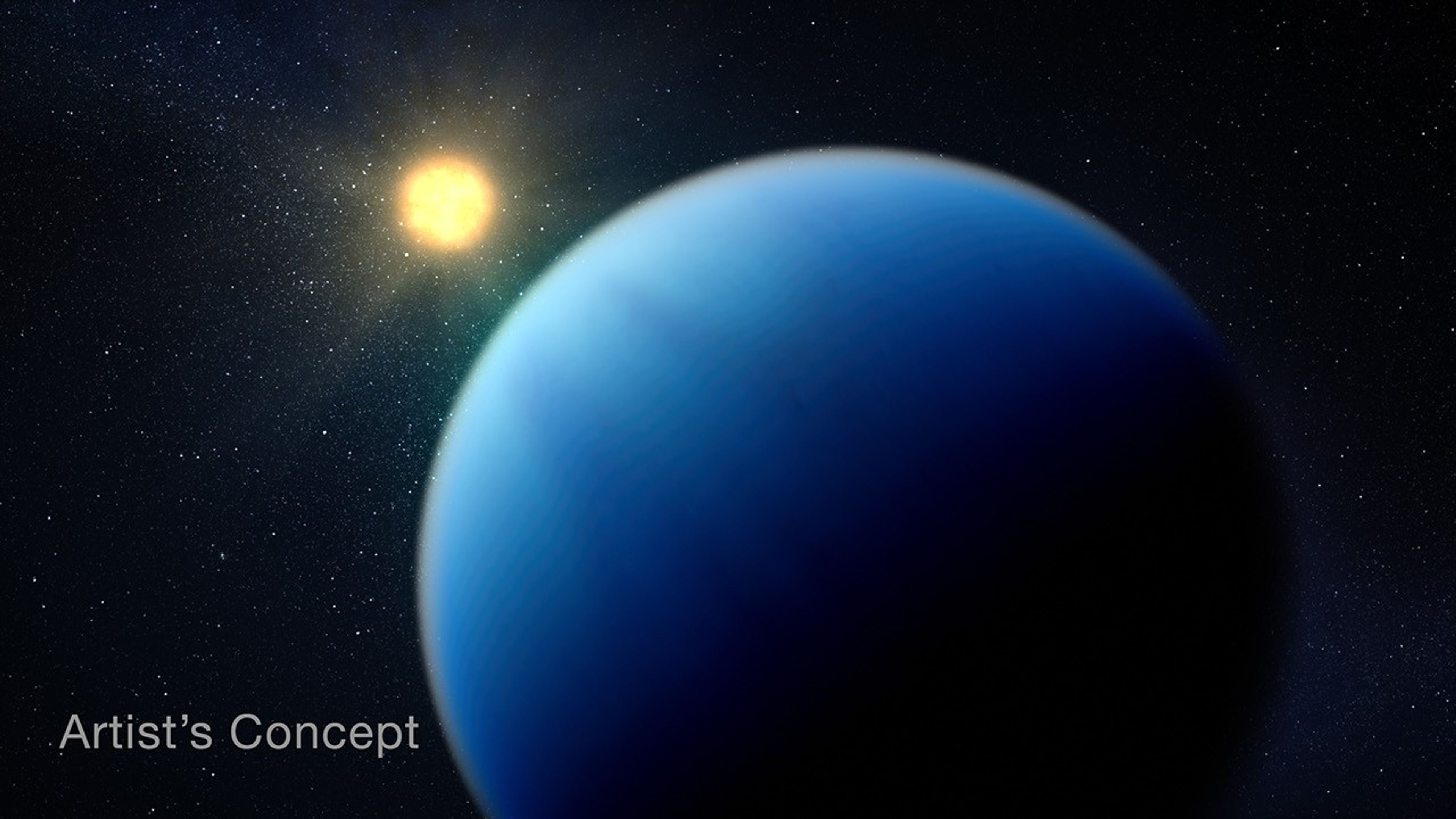
Small, Cool, Shrouded in Haze
The existence of sub-Neptunes was unexpected before they were discovered by NASA’s retired Kepler space telescope in the last decade. Now, astronomers are trying to understand where these planets came from and why are they so common.
Before Webb, scientists had very little information on them. While sub-Neptunes are a few times larger than Earth, they are still much smaller than gas-giant planets and typically cooler than hot Jupiters, making them much more challenging to observe than their gas-giant counterparts.
A key finding prior to Webb was that most sub-Neptune atmospheres had flat or featureless transmission spectra. This means that when scientists observed the spectrum of the planet as it passed in front of its host star, instead of seeing spectral features – the chemical fingerprints that would reveal the composition of the atmosphere – they saw only a flat-line spectrum. Astronomers concluded from all of those flat-line spectra that at least certain sub-Neptunes were probably very highly obscured by either clouds or hazes.
Image B: Spectrum of TOI-421 b
A Different Kind of Sub-Neptune?
“Why did we observe this planet, TOI-421 b? It's because we thought that maybe it wouldn't have hazes,” said Kempton. “And the reason is that there were some previous data that implied that maybe planets over a certain temperature range were less enshrouded by haze or clouds than others.”
That temperature threshold is about 1,070 degrees Fahrenheit. Below that, scientists hypothesized that a complex set of photochemical reactions would occur between sunlight and methane gas, and that would trigger the haze. But hotter planets shouldn't have methane and therefore perhaps shouldn't have haze.
The temperature of TOI-421 b is about 1,340 degrees Fahrenheit, well above the presumed threshold. Without haze or clouds, researchers expected to see a clear atmosphere – and they did!
A Surprising Finding
“We saw spectral features that we attribute to various gases, and that allowed us to determine the composition of the atmosphere,” said the University of Maryland’s Brian Davenport, a third-year Ph.D. student who conducted the primary data analysis. “Whereas with many of the other sub-Neptunes that had been previously observed, we know their atmospheres are made of something, but they're being blocked by haze.”
The team found water vapor in the planet’s atmosphere, as well as tentative signatures of carbon monoxide and sulfur dioxide. Then there are molecules they didn’t detect, such as methane and carbon dioxide. From the data, they can also infer that a large amount of hydrogen is in TOI-421 b’s atmosphere.
The lightweight hydrogen atmosphere was the big surprise to the researchers. “We had recently wrapped our mind around the idea that those first few sub-Neptunes observed by Webb had heavy-molecule atmospheres, so that had become our expectation, and then we found the opposite,” said Kempton. This suggests TOI-421 b may have formed and evolved differently from the cooler sub-Neptunes observed previously.
Is TOI-421 b Unique?
The hydrogen-dominated atmosphere is also interesting because it mimics the composition of TOI-421 b's host star. “If you just took the same gas that made the host star, plopped it on top of a planet's atmosphere, and put it at the much cooler temperature of this planet, you would get the same combination of gases. That process is more in line with the giant planets in our solar system, and it is different from other sub-Neptunes that have been observed with Webb so far,” said Kempton.
Aside from being hotter than other sub-Neptunes previously observed with Webb, TOI-421 b orbits a Sun-like star. Most of the other sub-Neptunes that have been observed so far orbit smaller, cooler stars called red dwarfs.
Is TOI-421b emblematic of hot sub-Neptunes orbiting Sun-like stars, or is it just that exoplanets are very diverse? To find out, the researchers would like to observe more hot sub-Neptunes to determine if this is a unique case or a broader trend. They hope to gain insights into the formation and evolution of these common exoplanets.
“We've unlocked a new way to look at these sub-Neptunes,” said Davenport. “These high-temperature planets are amenable to characterization. So by looking at sub-Neptunes of this temperature, we're perhaps more likely to accelerate our ability to learn about these planets.”
The team’s findings appear on May 5 in The Astrophysical Journal Letters.
The James Webb Space Telescope is the world’s premier space science observatory. Webb is solving mysteries in our solar system, looking beyond to distant worlds around other stars, and probing the mysterious structures and origins of our universe and our place in it. Webb is an international program led by NASA with its partners, ESA (European Space Agency) and CSA (Canadian Space Agency).
Quelle: NASA
----
Update: 14.05.2025
.
NASA’s Webb Reveals New Details, Mysteries in Jupiter’s Aurora
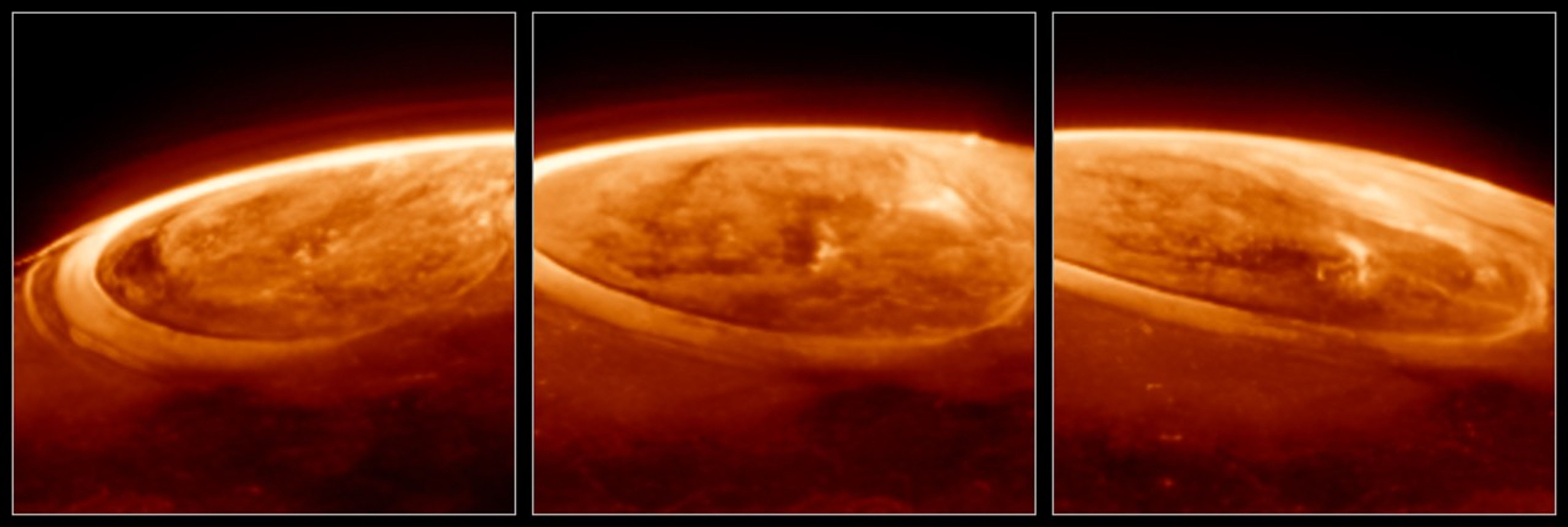
NASA’s James Webb Space Telescope has captured new details of the auroras on our solar system’s largest planet. The dancing lights observed on Jupiter are hundreds of times brighter than those seen on Earth. With Webb’s advanced sensitivity, astronomers have studied the phenomena to better understand Jupiter’s magnetosphere.
Auroras are created when high-energy particles enter a planet’s atmosphere near its magnetic poles and collide with atoms or molecules of gas. On Earth these are known as the Northern and Southern Lights. Not only are the auroras on Jupiter huge in size, they are also hundreds of times more energetic than those in Earth’s atmosphere. Earth’s auroras are caused by solar storms — when charged particles from the Sun rain down on the upper atmosphere, energize gases, and cause them to glow in shades of red, green and purple.
Image A: Close-up Observations of Auroras on Jupiter
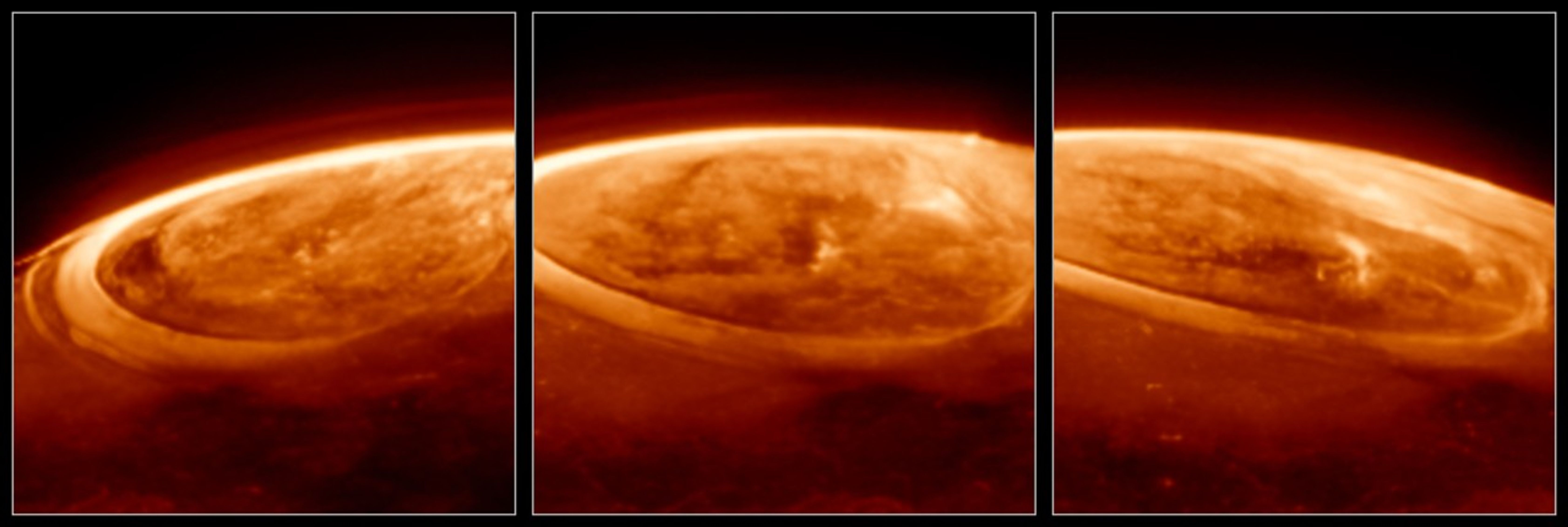
These observations of Jupiter’s auroras, taken at a wavelength of 3.36 microns (F335M) were captured with Webb’s NIRCam (Near-Infrared Camera) on Dec. 25, 2023. Scientists found that the emission from trihydrogen cation, known as H3+, is far more variable than previously believed. H3+ is created by the impact of high energy electrons on molecular hydrogen. Because this emission shines brightly in the infrared, Webb’s instruments are well equipped to observe it.
Jupiter has an additional source for its auroras: The strong magnetic field of the gas giant grabs charged particles from its surroundings. This includes not only the charged particles within the solar wind but also the particles thrown into space by its orbiting moon Io, known for its numerous and large volcanoes. Io’s volcanoes spew particles that escape the moon’s gravity and orbit Jupiter. A barrage of charged particles unleashed by the Sun also reaches the planet. Jupiter’s large and powerful magnetic field captures all of the charged particles and accelerates them to tremendous speeds. These speedy particles slam into the planet’s atmosphere at high energies, which excites the gas and causes it to glow.
Image B: Pullout of Aurora Observations on Jupiter (NIRCam Image)

Now, Webb’s unique capabilities are providing new insights into the auroras on Jupiter. The telescope’s sensitivity allows astronomers to capture fast-varying auroral features. New data was captured with Webb’s NIRCam (Near-Infrared Camera) Dec. 25, 2023, by a team of scientists led by Jonathan Nichols from the University of Leicester in the United Kingdom.
“What a Christmas present it was – it just blew me away!” shared Nichols. “We wanted to see how quickly the auroras change, expecting them to fade in and out ponderously, perhaps over a quarter of an hour or so. Instead, we observed the whole auroral region fizzing and popping with light, sometimes varying by the second.”
In particular, the team studied emission from the trihydrogen cation (H3+), which can be created in auroras. They found that this emission is far more variable than previously believed. The observations will help develop scientists’ understanding of how Jupiter’s upper atmosphere is heated and cooled.
The team also uncovered some unexplained observations in their data.
“What made these observations even more special is that we also took pictures simultaneously in the ultraviolet with NASA’s Hubble Space Telescope,” added Nichols. “Bizarrely, the brightest light observed by Webb had no real counterpart in Hubble’s pictures. This has left us scratching our heads. In order to cause the combination of brightness seen by both Webb and Hubble, we need to have a combination of high quantities of very low-energy particles hitting the atmosphere, which was previously thought to be impossible. We still don’t understand how this happens.”
Video: Webb Captures Jupiter’s Aurora
Producer: Paul Morris. Writer: Thaddeus Cesari. Narrator: Professor Jonathan Nichols. Images: NASA, ESA, CSA, STScI. Music Credit: "Zero Gravity" by Brice Davoli [SACEM] via Koka Media [SACEM], Universal Production Music France [SACEM], and Universal Production Music.
The team now plans to study this discrepancy between the Hubble and Webb data and to explore the wider implications for Jupiter’s atmosphere and space environment. They also intend to follow up this research with more Webb observations, which they can compare with data from NASA’s Juno spacecraft to better explore the cause of the enigmatic bright emission.
These results were published today in the journal Nature Communications.
The James Webb Space Telescope is the world’s premier space science observatory. Webb is solving mysteries in our solar system, looking beyond to distant worlds around other stars, and probing the mysterious structures and origins of our universe and our place in it. Webb is an international program led by NASA with its partners, ESA (European Space Agency) and CSA (Canadian Space Agency).
Quelle: NASA
----
Update: 16.05.2025
.
Webb’s Titan Forecast: Partly Cloudy With Occasional Methane Showers
Saturn’s moon Titan is an intriguing world cloaked in a yellowish, smoggy haze. Similar to Earth, the atmosphere is mostly nitrogen and has weather, including clouds and rain. Unlike Earth, whose weather is driven by evaporating and condensing water, frigid Titan has a methane cycle.
NASA’s James Webb Space Telescope, supplemented with images from the Keck II telescope, has for the first time found evidence for cloud convection in Titan’s northern hemisphere, over a region of lakes and seas. Webb also has detected a key carbon-containing molecule that gives insight into the chemical processes in Titan’s complex atmosphere.
Titan’s Weather
On Titan, methane plays a similar role to water on Earth when it comes to weather. It evaporates from the surface and rises into the atmosphere, where it condenses to form methane clouds. Occasionally it falls as a chilly, oily rain onto a solid surface where water ice is hard as rocks.
“Titan is the only other place in our solar system that has weather like Earth, in the sense that it has clouds and rainfall onto a surface,” explained lead author Conor Nixon of NASA’s Goddard Space Flight Center in Greenbelt, Maryland.
The team observed Titan in November 2022 and July 2023 using both Webb and one of the twin ground-based W.M. Keck Observatories telescopes. Those observations not only showed clouds in the mid and high northern latitudes on Titan – the hemisphere where it is currently summer – but also showed those clouds apparently rising to higher altitudes over time. While previous studies have observed cloud convection at southern latitudes, this is the first time evidence for such convection has been seen in the north. This is significant because most of Titan’s lakes and seas are located in its northern hemisphere and evaporation from lakes is a major potential methane source. Their total area is similar to that of the Great Lakes in North America.
On Earth the lowest layer of the atmosphere, or troposphere, extends up to an altitude of about 7 miles (12 kilometers). However, on Titan, whose lower gravity allows the atmospheric layers to expand, the troposphere extends up to about 27 miles (45 kilometers). Webb and Keck used different infrared filters to probe to different depths in Titan’s atmosphere, allowing astronomers to estimate the altitudes of the clouds. The science team observed clouds that appeared to move to higher altitudes over a period of days, although they were not able to directly see any precipitation occurring.
Image A: Titan (Webb and Keck Image)
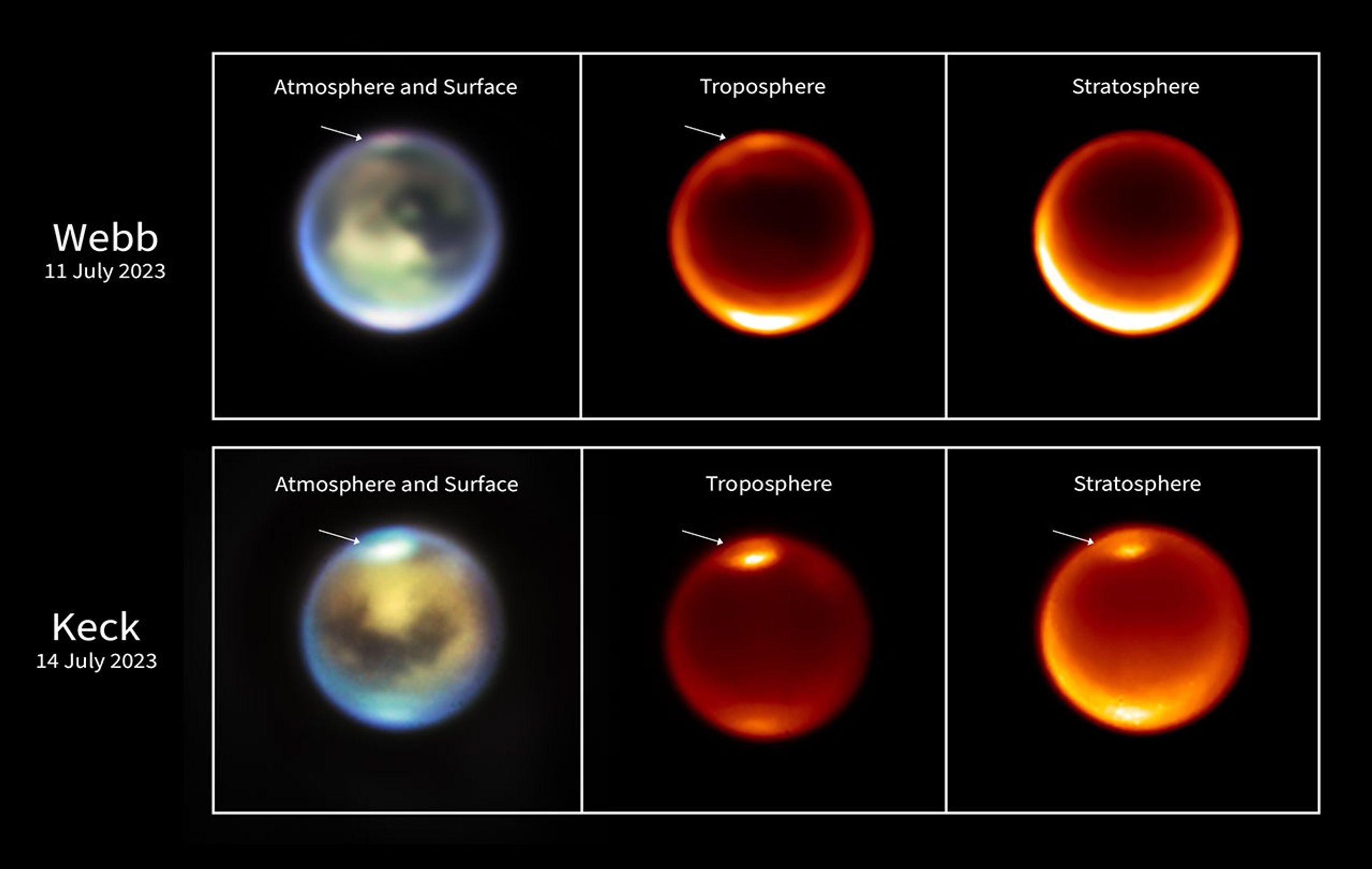
On the left side are representative-color images from both telescopes. In the Webb image light at 1.4 microns is colored blue, 1.5 microns is green, and 2.0 microns is red (filters F140M, F150W, and F200W, respectively). In the Keck image light at 2.13 microns is colored blue, 2.12 microns is green, and 2.06 microns is red (H2 1-0, Kp, and He1b, respectively).
In the middle column are single-wavelength images taken by Webb and Keck at 2.12 microns. This wavelength is sensitive to emission from Titan’s lower troposphere. The rightmost images show emission at 1.64 microns (Webb) and 2.17 microns (Keck), which favor higher altitudes, in Titan’s upper troposphere and stratosphere (an atmospheric layer above the troposphere). It demonstrates that the clouds are seen at higher altitudes on July 14 than earlier on July 11, indicative of upward motion.
Titan’s Chemistry
Titan is an object of high astrobiological interest due to its complex organic (carbon-containing) chemistry. Organic molecules form the basis of all life on Earth, and studying them on a world like Titan may help scientists understand the processes that led to the origin of life on Earth.
The basic ingredient that drives much of Titan’s chemistry is methane, or CH4. Methane in Titan’s atmosphere gets split apart by sunlight or energetic electrons from Saturn’s magnetosphere, and then recombines with other molecules to make substances like ethane (C2H6) along with more complex carbon-bearing molecules.
Webb’s data provided a key missing piece for our understanding of the chemical processes: a definitive detection of the methyl radical CH3. This molecule (called “radical” because it has a “free” electron that is not in a chemical bond) forms when methane is broken apart. Detecting this substance means that scientists can see chemistry in action on Titan for the first time, rather than just the starting ingredients and the end products.
“For the first time we can see the chemical cake while it’s rising in the oven, instead of just the starting ingredients of flour and sugar, and then the final, iced cake,” said co-author Stefanie Milam of the Goddard Space Flight Center.
Image B: Chemistry in Titan's Atmosphere
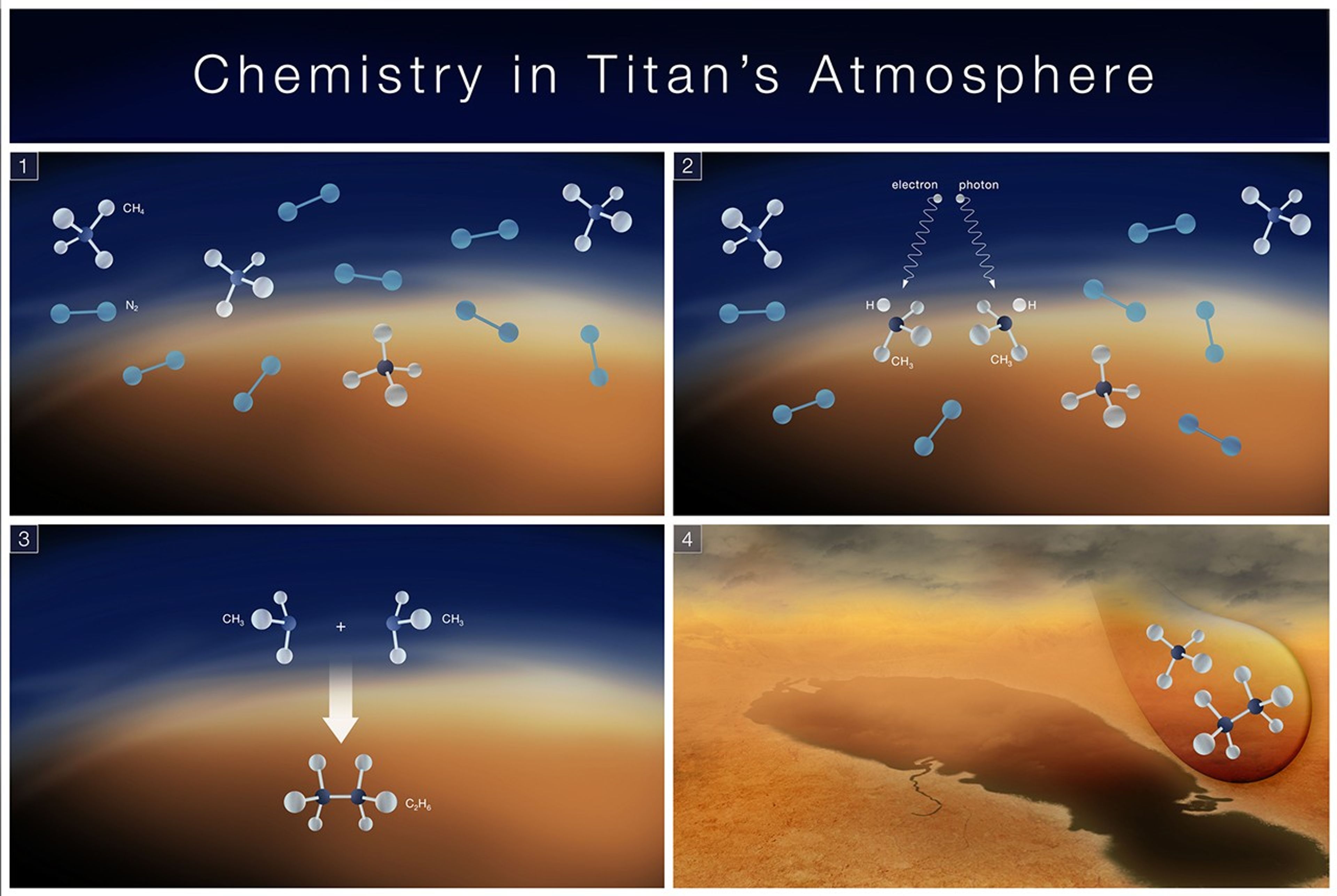
1. Titan has a thick, nitrogen (N2) atmosphere that also contains methane (CH4).
2. Molecules known as methyl radicals (CH3) form when methane is broken apart by sunlight or energetic electrons from Saturn’s magnetosphere.
3. It then recombines with other molecules or with itself to make substances like ethane (C2H6).
4. Methane, ethane, and other molecules condense and rain out of the atmosphere, forming lakes and seas on Titan’s surface. NASA’s James Webb Space Telescope detected the methyl radical on Titan for the first time, providing a key missing piece for our understanding of Titan’s chemical processes.
The Future of Titan’s Atmosphere
This hydrocarbon chemistry has long-term implications for the future of Titan. When methane is broken apart in the upper atmosphere, some of it recombines to make other molecules that eventually end up on Titan’s surface in one chemical form or another, while some hydrogen escapes from the atmosphere. As a result, methane will be depleted over time, unless there is some source to replenish it.
A similar process occurred on Mars, where water molecules were broken up and the resulting hydrogen lost to space. The result was the dry, desert planet we see today.
“On Titan, methane is a consumable. It’s possible that it is being constantly resupplied and fizzing out of the crust and interior over billions of years. If not, eventually it will all be gone and Titan will become a mostly airless world of dust and dunes,” said Nixon.
Video: Webb Spies Rain Clouds, New Molecule on Titan
Credit: NASA’s Goddard Space Flight Center. Producer/Editor: Dan Gallagher. Lead Scientist/Narrator: Conor Nixon. Lead Animator: Jenny McElligott. Lead Visualizer: Andrew J Christensen. Scientist: Nicholas Lombardo. Animator/Art Director: Michael Lentz. Animation Lead: Walt Feimer. Animators: Jonathan North, Wes Buchanan, Kim Dongjae, Chris Meaney, Adriana Manrique Gutierrez. Data Visualizers: Mark SubbaRao, Kel Elkins, Ernie Wright. Data Provider: Juan Lora. Executive Producer: Wade Sisler. Social Media Support: Kathryn Mersmann. Public Affairs: Laura Betz.
Complementing the Dragonfly Mission
More of Titan’s mysteries will be probed by NASA’s Dragonfly mission, a robotic rotorcraft scheduled to land on Saturn’s moon in 2034. Making multiple flights, Dragonfly will explore a variety of locations. Its in-depth investigations will complement Webb’s global perspective.
“By combining all of these resources, including Webb, NASA’s Hubble Space Telescope, and ground-based observatories, we maintain continuity between the former Cassini/Huygens mission to Saturn and the upcoming Dragonfly mission,” added Heidi Hammel, vice president of the Association of Universities for Research in Astronomy and a Webb Interdisciplinary Scientist.
This data was taken as part of Hammel’s Guaranteed Time Observations program to study the Solar System. The results were published in the journal Nature Astronomy.
The James Webb Space Telescope is the world’s premier space science observatory. Webb is solving mysteries in our solar system, looking beyond to distant worlds around other stars, and probing the mysterious structures and origins of our universe and our place in it. Webb is an international program led by NASA with its partners, ESA (European Space Agency) and CSA (Canadian Space Agency).
Quelle: NASA
----
Update: 21.05.2025
.
James Webb Space Telescope discovers an alien planetary system's icy edge

